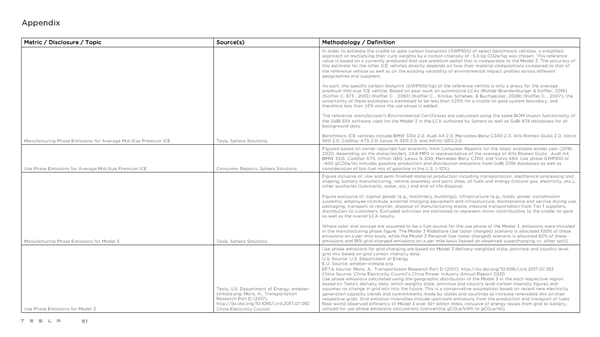Appendix Metric / Disclosure / Topic Source(s) Methodology / Definition In order to estimate the cradle-to-gate carbon footprints (GWP100) of select benchmark vehicles, a simplified approach of multiplying their curb weights by a carbon intensity of ~5.5 kg CO2e/kg was chosen. This reference value is based on a currently produced mid-size premium sedan that is comparable to the Model 3. The accuracy of this estimate for the other ICE vehicles directly depends on how their material compositions compared to that of the reference vehicle as well as on the existing variability of environmental impact profiles across different geographies and suppliers. As such, the specific carbon footprint (GWP100/kg) of the reference vehicle is only a proxy for the average premium mid-size ICE vehicle. Based on past work on automotive LCAs (Rohde-Brandenburger & Koffler, 2019) (Koffler C. 873 , 2013) (Koffler C. , 2010) (Koffler C. , Krinke, Schebek, & Buchgeister, 2008) (Koffler C. , 2007), the uncertainty of these estimates is estimated to be less than ±20% for a cradle-to-gate system boundary, and therefore less than ±5% once the use phase is added. The reference manufacturer’s Environmental Certificates are calculated using the same BOM import functionality of the GaBi DfX software used for the Model 3 in the LCA authored by Sphera as well as GaBi 878 databases for all background data. Benchmark ICE vehicles include BMW 330i 2.0, Audi A4 2.0, Mercedes-Benz C300 2.0, Alfa Romeo Giulia 2.0, Volvo Manufacturing Phase Emissions for Average Mid-Size Premium ICE Tesla, Sphera Solutions S60 2.0, Cadillac ATS 2.0, Lexus IS 300 2.0, and Infiniti Q50 2.0. Figured based on owner-reported fuel economy from Consumer Reports for the latest available model year (2018- 2020, depending on the make/model). 24.8 MPG is representative of the average of Alfa Romeo Giulia , Audi A4, BMW 330i, Cadillac ATS, Infiniti Q50, Lexus IS 300, Mercedes-Benz C300, and Volvo S60. Use phase GWP100 of ~400 gCO2e/mi includes gasoline production and distribution emissions from GaBi 2019 databases as well as Use Phase Emissions for Average Mid-Size Premium ICE Consumer Reports, Sphera Solutions consideration of bio-fuel mix of gasoline in the U.S. (~12%). Figure inclusive of: raw and semi-finished material production including transportation, mechanical processing and shaping, battery manufacturing, vehicle assembly and paint shop, all fuels and energy (natural gas, electricity, etc.), other auxiliaries (lubricants, water, etc.) and end-of-life disposal. Figure exclusive of: capital goods (e.g., machinery, buildings), infrastructure (e.g., roads, power transmission systems), employee commute, external charging equipment and infrastructure, maintenance and service during use, packaging, transport to recycler, disposal of manufacturing waste, inbound transportation from Tier 1 suppliers, distribution to customers. Excluded activities are estimated to represent minor contributions to the cradle-to-gate as well as the overall LCA results. Where solar and storage are assumed to be a fuel source for the use phase of the Model 3, emissions were included in the manufacturing phase figure. The Model 3 Rideshare Use (solar charged) scenario is allocated 100% of these emissions on a per mile basis, while the Model 3 Personal Use (solar charged) scenario is allocated 82% of these Manufacturing Phase Emissions for Model 3 Tesla, Sphera Solutions emissions and 18% grid-charged emissions on a per mile basis (based on observed supercharging vs. other split). Use phase emissions for grid charging are based on Model 3 delivery-weighted state, province and country level grid mix based on grid carbon intensity data. U.S. Source: U.S. Department of Energy E.U. Source: emeber-climate.org EFTA Source: Moro, A., Transportation Research Part D (2017), http://dx.doi.org/10.1016/j.trd.2017.07.012 China Source: China Electricity Council's China Power Industry Annual Report 2020 Use phase emissions calculated using the geographic distribution of the Model 3 in the each respective region based on Tesla's delivery data, which weights state, province and country level carbon intensity figures and Tesla; U.S. Department of Energy; emeber- assumes no change in grid mix into the future. This is a conservative assumption based on recent new electricity climate.org; Moro, A., Transportation generation capacity trends and commitments made by states and countries to increase renewable mix on their Research Part D (2017), respective grids. Grid emission intensities include upstream emissions from the production and transport of fuels. http://dx.doi.org/10.1016/j.trd.2017.07.012; Real-world observed efficiency of Model 3 over 10+ billion miles, inclusive of energy losses from grid to battery, Use Phase Emissions for Model 3 China Electricity Council utilized for use phase emissions calculations (converting gCO e/kWh to gCO e/mi). 2 2 91
 Tesla Impact Report 2020 Page 90 Page 92
Tesla Impact Report 2020 Page 90 Page 92